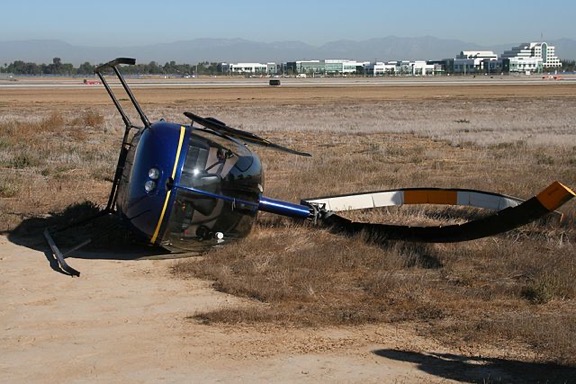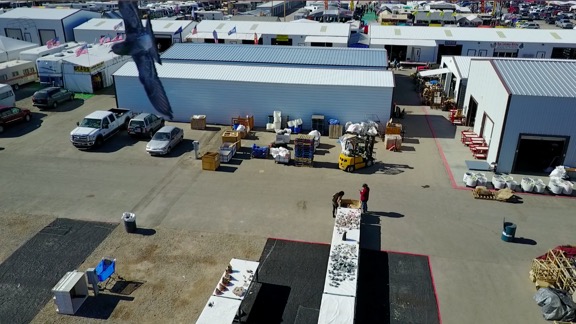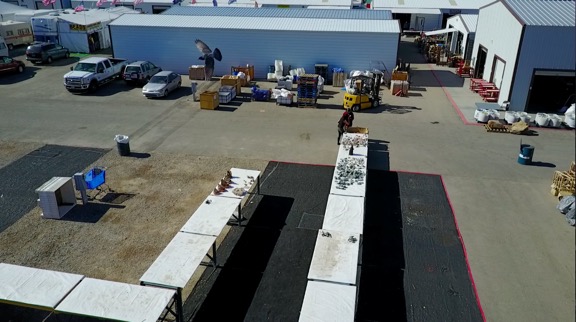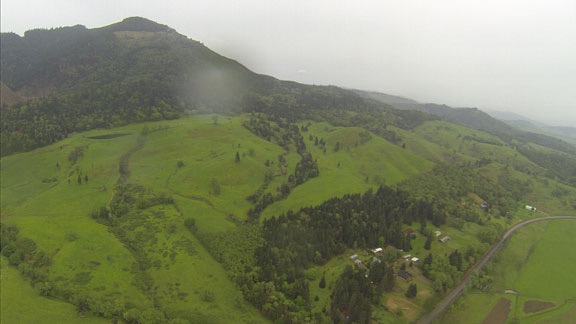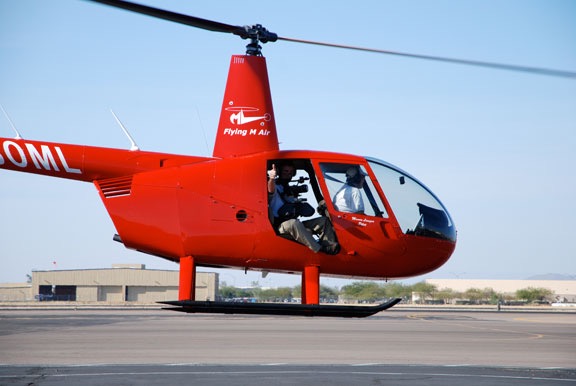Just because you can do something, doesn’t mean you should do it.
Every once in a while someone watching one of my YouTube videos or searching for answers on the web that bring them to this blog ask why helicopters don’t take off straight up. I guess these folks know that it’s possible and they’ve seen it often enough in the movies to think that it’s normal or at least okay. It’s neither.
I actually explain why in my much longer post about the Deadman’s Curve. But I’ll try to keep it simpler here.
The Basics
Let me start off by saying that helicopters can glide. Yes, if the engine fails, the pilot still has control over the helicopter and can fly it, using autorotation, to the ground. If conditions are right and the landing zone is appropriate and the pilot’s skills are sufficient, the pilot and passengers should be able to walk away and the helicopter might even be able to fly again.
Notice that I mentioned three ifs:
- if the conditions are right
- if the landing zone is appropriate
- if the pilot’s skills are sufficient
 It’s that first if that the pilot usually has complete control over: the conditions of flight. That’s where the Height-Velocity Diagram comes into play. This diagram, which is part of the Pilot Operating Handbook (POH) that pilots are required to know inside and out (and even carry on board, as if we could consult it while flying), shows the flight profiles in which an autorotation is most likely to be completed successfully. By “flight profiles,” I’m referring to a combination of airspeed and altitude.
It’s that first if that the pilot usually has complete control over: the conditions of flight. That’s where the Height-Velocity Diagram comes into play. This diagram, which is part of the Pilot Operating Handbook (POH) that pilots are required to know inside and out (and even carry on board, as if we could consult it while flying), shows the flight profiles in which an autorotation is most likely to be completed successfully. By “flight profiles,” I’m referring to a combination of airspeed and altitude.
To meet the requirements of that first if — in other words, to fly the safest flight profile in the unlikely event of an engine failure — the pilot needs to stay out of the shaded area of the Height-Velocity Diagram. A recommended takeoff profile is shown on this chart by a dashed line that starts at 0 knots and less than 10 feet off the ground, accelerates through 45 knots while climbing less than 15 feet, and then climbs out at a speed greater than 50 knots.
Make a mental picture of that. If you’re not going to climb above 10 feet until you get to at least 30 or 40 knots, are you going to be flying straight up? No. You’re going to be taking off a lot like an airplane might, with a bunch of forward movement before you start climbing.
This is why a “normal takeoff” for a helicopter climbs out after gaining airspeed — instead of climbing straight up. It’s for safety reasons.
(This is only part of the reason why we don’t land straight down, but I’ll save that for another blog post if I get requests for it.)
FAA Guidance
The FAA has a wealth of free information about flying, including “handbooks” that explain exactly how to fly. I’ve linked to the Helicopter Flying Handbook many times; if you don’t have a copy of this excellent guide and are interested in flying helicopters, download it in PDF format here.
Here’s what it says about performing a normal takeoff from a hover (position 1 in the image that follows) on Page 9-12:
Start the helicopter moving by smoothly and slowly easing the cyclic forward (position 2). As the helicopter starts to move forward, increase the collective, as necessary, to prevent the helicopter from sinking and adjust the throttle to maintain rpm. The increase in power requires an increase in the proper antitorque pedal to maintain heading. Maintain a straight takeoff path throughout the takeoff.
While accelerating through effective translational lift (position 3), the helicopter begins to climb, and the nose tends to rise due to increased lift. At this point, adjust the collective to obtain normal climb power and apply enough forward cyclic to overcome the tendency of the nose to rise. At position 4, hold an attitude that allows a smooth acceleration toward climbing airspeed and a commensurate gain in altitude so that the takeoff profile does not take the helicopter through any of the cross-hatched or shaded areas of the height/velocity diagram. As airspeed increases (position 5), place the aircraft in trim and allow a crab to take place to maintain ground track and a more favorable climb configuration. As the helicopter continues to climb and accelerate to best rate-of-climb, apply aft cyclic pressure to raise the nose smoothly to the normal climb attitude.
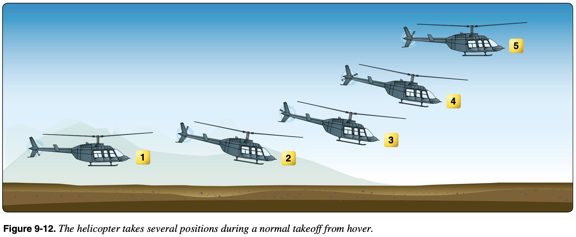
This is an exaggerated view. In reality, each position would be a lot farther apart horizontally.
In the above text, in an R44, effective translational lift (ETL) occurs between 15 and 25 knots, normal climb power is about 45 knots, and then climb out power (best rate of climb) is 60 knots. So you basically stay within 10 feet of the ground until you’re at 45 knots, then accelerate while climbing to 60 knots, and then climb out at 60. These numbers may be different for other aircraft but are likely similar.
Real Life Situations
Time for a shameless plug…
If you like helicopters, you’ll love the FlyingMAir YouTube Channel. Check it out for everything from time-lapse annual inspections to cockpit POV autorotation practice to a flight home from a taco dinner at a friend’s house — and more.
Of course, one of the benefits of helicopters in many operational situations is that it can fly straight up. For example, I can take off from a confined space — perhaps a forest clearing — by being able to climb up above obstacles (the trees around me) before picking up airspeed and flying away. Is this safe? Well, there isn’t any signifiant danger unless the engine quits. And although the chances of the engine quitting are very slim, it is possible.
Years ago, while doing a rides event at the local airport with some fellow pilots who were working with me for cherry season, I noticed that one of the pilots was departing our landing zone by climbing straight up for 20 or 30 or even 50 feet before gaining airspeed. He was putting the aircraft right in the shaded area of the Height-Velocity Diagram. In other words, he was adding risk to his flight by basically ignoring the recommended takeoff profile.
With passengers on board. At a crowded event.
I’ve got a pretty good imagination and was immediately able to “see” what could happen if his engine quit. The helicopter would drop down with its blades still spinning. Everyone on board would likely be killed or seriously injured. And when all those spinning parts hit the ground and started flinging off in every direction, they’d likely kill or injure dozens of onlookers.
What were the chances of his engine quitting? About as close to zero as you can get without being zero. But that isn’t zero. It could happen.
After seeing him do this at least four times and realizing he wasn’t going to stop, I got on the radio and told him to stop. He asked me why. Knowing that I was talking on a frequency that could be heard by his passengers, my passengers, any other aircraft flying around the area, and anyone monitoring on the ground, I kept it simple: “Just because you can do something doesn’t mean you should.” I let him think a bit about why he shouldn’t and he stopped. (If he didn’t, I would have kicked him out of the event.)
Over the following month or so, I got to know this pilot better and I didn’t like what I saw. I don’t need to go into details here, but I feel that he’s the kind of pilot who will likely get himself killed doing something dumb in a helicopter. I’m just glad I took steps to make sure it didn’t happen on my watch.
Question Answered?
If this doesn’t answer the question about why helicopters don’t take off vertically, I don’t know what could. Please don’t hesitate to share your questions, comments, and stories in the comments for this post. Thanks!

